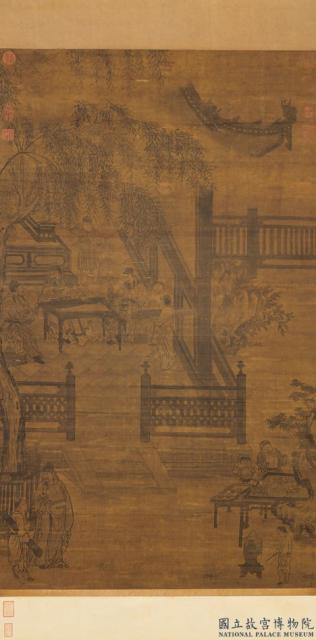元人畫春堂琴韻 軸
推薦分享
資源連結
連結到原始資料 (您即將開啟新視窗離開本站)後設資料
- 資料識別:
- 故畫000358N000000000
- 資料類型:
- 類型:繪畫
- 型式:靜態圖像
- 主題與關鍵字:
- 高士(士人、隱士) 臺閣 傢俱(屏風) 文玩(琴棋書畫) 奇石 楊柳 庭院 欄杆 飲食器 樂器 春景 侍從(侍女、童僕) 文房用具
- 出版者:
- 數位化執行單位:國立故宮博物院
- 格式:
- 本幅 133.6x79.8公分、全幅 81公分
- 關聯:
- 石渠寶笈三編(延春閣),第四冊,頁1692&*故宮書畫錄(卷五),第三冊,頁259&*故宮書畫圖錄,第五冊,頁193-194&*這是一組四幅的連作,內容描繪文人雅士寄興於琴棋書畫。四幅畫一共有十八位文士,徜徉於園林之中。 這類題材與唐宋時代的「十八學士圖」有密切的關係:唐太宗(在位於西元六二六—六四九年)時代禮賢下士,設立文學館,聘請杜如晦、房玄齡等十八位博學之士為文學館學士,並命當時大畫家閻立本圖像,是為「十八學士圖」。 本幅繪春景。垂楊繞榭,亭中一人撫琴,二人環聽,又一人自外來,奚奴抱琴隨之。&*This work is one of a set of four representing the elegant past-times of scholars in traditional China, including such activities as playing the zither, playing chess, appreciating painting, and practicing calligraphy. The four hanging scrolls here include altogether eighteen scholars depicted in garden settings. This subject matter is closely related to that of the Eighteen Scholars found in T'ang and Sung art. Emperor T'ai-tsung of the T'ang (r. 626-649) treated sages and scholars with respect. He established the Hall of Literary Achievements and invited eighteen learned scholars, including Tu Ju-hui and Fang Hsuan-ch'ih, to be academicians there. The emperor then ordered the court painter, Yen Li-pen, to render their portraits, which became known as "The Eighteen Scholars." This painting is a depiction of spring scenery; in a pavilion under a weeping willow, a figure plays the zither while another listens. A figure approaches in the lower left accompanied by a servant holding a wrapped zither.
- 管理權:
- 國立故宮博物院
授權聯絡窗口
- 國立故宮博物院圖像授權、出版授權、影音資料授權-申請流程說明
http://www.npm.gov.tw/zh-TW/Article.aspx?sNo=03003061






